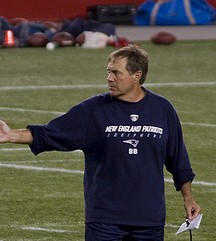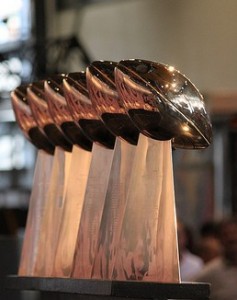Can You Copyright a Football Play? Ask Bill Belichick
Just about a year ago we posted about the incredibly innovative game of football. As we described, all of the innovation we’ve seen in football – the spread offense, the zone blitz, the wildcat, and dozens of other offensive and defensive formations, strategies, and counter-strategies – occurs without anyone ever asserting ownership. Rival teams are free to copy new plays, and they do.
It’s not as if ownership would be impossible – existing intellectual property rules might cover at least some football innovations as copyrightable “choreographic works,” or as patentable processes. The fact remains, however, that no one has ever tried to copyright or patent a new play or formation.
 Photo: Andrew Choy
Photo: Andrew ChoyA new football season has started, and with it, another football innovation. This time it’s the Buffalo Bills, under head coach Chan Gailey (who has a strong reputation for offensive innovation). The Bills are using a new offensive formation that builds on an earlier innovation that’s usually credited to New England Patriots head coach Bill Belichick (although Belichick’s sole authorship has never been established). Belichick’s Pats often run an offense that foregoes running backs in favor of extra receivers pushed up close to the line of scrimmage and running unconventional routes. The extra receivers swarm the secondary, overloading the defensive backs, and creating openings that Tom Brady (the Patriots’ quarterback) is usually able to exploit.
The Bills have tweaked the Pats’ innovation by mashing up Belichick’s extra-receivers formation with a move that every kid who plays pick-up basketball knows: the pick. Setting picks – i.e., using one receiver to obstruct a defender’s access to another receiver who is not carrying the ball – is generally against the rules in football (it is treated as offensive pass interference). But there is a loophole. If the pick is the result of the receivers’ normal passing routes, it won’t draw a flag.
The Bills aren’t the first team to set picks – the San Francisco 49ers under Bill Walsh were adept at setting picks as part of their West Coast offense. Other teams have done it as well by bunching receivers.
But the Bills have now advanced the state of the art, ingeniously, by “stacking” receivers at the line of scrimmage. Here is a picture of the stacking formation from a recent article in the Wall Street Journal. Unlike previous “natural” picks, which depend on exact timing of receivers’ routes, in the Bills’ stacking formation the first receiver can more easily set a pick because the receiver directly behind him is running a following route — at least until the pick is set and the second man veers off, away from the blocked-out defenders. Ironically, this is the formation that the Bills used to beat Belichick’s Pats last Sunday, 34-31.
That last bit illustrates our point nicely. Bill Belichick innovated, but others followed. Belichick knew that he would be copied, and, even more importantly, that his rivals would tweak – and perhaps improve upon – his innovation. And then turn that improvement against him, as the Bills did last Sunday.
 Photo: daveynin
Photo: daveyninAnd yet Belichick, and dozens of great football coaches over the years, continue to be creative. Why? Professional football is the apotheosis of cutthroat competition. In the NFL, innovations can pay even if they provide an advantage over only a few games (although for reasons we’ve explained, copying a football coach’s innovation effectively is often more difficult than it may at first appear). A few extra games in the win column are the difference between a decent season and playing in the Super Bowl. And even one Super Bowl win turns a coach into a hero. That gleaming, buffed Lombardi trophy prize drives innovation in football more surely than any rule of intellectual property.

Comments